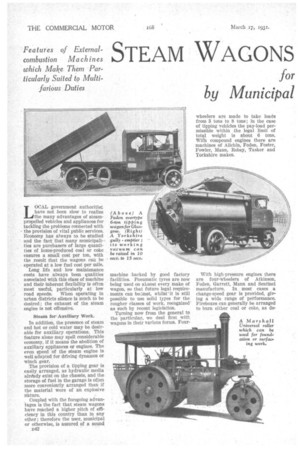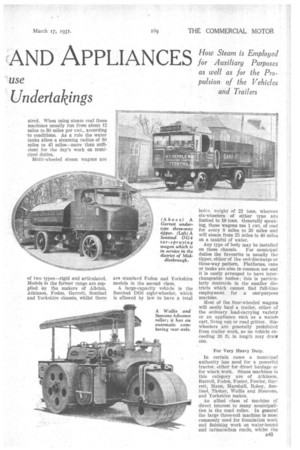STEAM WAGONS AND APPLIANCES
Page 112

Page 113

Page 114

If you've noticed an error in this article please click here to report it so we can fix it.
for use
by Municipal Undertakings
LOCAL government authorities have not been slow to realize the many advantages of steampropelled vehicles and appliances for tackling the problems connected with the provision of vital public services. Economy has always to be studied and the fact that many municipalities are purchasers of large quantities of home-produced coal or coke ensures a small cost per ton, with the result that the wagons can be operated at a low fuel cost per mile.
Long life and low maintenance costs have always been qualities associated with this class of machine and their inherent flexibility is often most useful, particularly at low road speeds. When operating in urban districts silence is much to be desired ; the exhaust of the steam engine is not offensive.
Steam for Auxiliary Work.
In addition, the presence of steam and hot or cold water may be desirable for auxiliary operations. This feature alone may spell considerable economy, if it means the abolition of auxiliary appliances or engines. The even speed of the steam engine is well adapted for driving dynamos or winch gear.
The provision of a tipping gear is easily arranged, as hydraulic media already exist on the chassis, and the storage of fuel in the garage is often more conveniently arranged than if the material were of an explosive nature.
Coupled with the foregoing advantages is the fact that steam wagons have reached a higher pitch of efficiency in this country than in any other ; therefore the user, municipal • or otherwise, is assured of a sound machine backed by good factory facilities. Pneumatic tyres are now being used on almost every make of wagon, so that future legal requiremeats can he net, whilst`it is still possible to use solid tyres for the rougher classes of work, recognized as such by recent legislation.
Turning now from the general to the particular, we deal first with wagons in their various forms. Four With high-pressure engines there are four-Wheelers of Atkinson, Foden, Garrett, Mann and Sentinel manufacture. In most cases a change-speed gear is provided, giving a wide range of performance. Fireboxes can generally be arranged to burn either coal or coke, as de sired. When using steam coal these machines usually run from about 12 miles to 30 miles per cwt., according -to conditions. As a rule the water tanks allow a steaming radius of 30 miles to 45 miles—more than sufficient for the day's work on municipal duties.
Multi-wheeled steam wagons are of two types--rigid and articulated. Models in the former range are supplied by the makers of Allchin, Atkinson, Foden, Garrett, Sentinel and Yorkshire chassis, whilst there are standard Foden and Yorkshire models in the second class.
A large-capacity vehicle is the Sentinel DG8 eight-wheeler, which is allowed by law to have a total laden • weight of 22 tons, whereas six-wheelers of either type are limited to 19 tons. Generally speaking, these wagons use 1 cwt. of coat for every $ miles to 20 miles and will steam from 25 miles to 40 miles on a tankful of water.
Any type of body may be installed
on these .chassis. For municipal duties the favourite is usually the tipper, either of the end-discharge or three-way pattern. Platforms, vans or tanks are also in common use and it is easily arranged to have interchangeable bodies ; this is particularly desirable in the smaller districts which cannot find full-time employment for a one-purpose machine.
Mostof the, four-wheeled wagons will easily haul a trailer, either of the ordinary load-carrying variety. or an appliance such as a watercart, living van or road gritter. Sixwheelers are generally prohibited from trailer work, as no vehicle exceeding 26 ft. in length may draw one.
For Very Heavy Duty.
In certain cases a municipal authority has need for a powerful tractor, either for direct haulage or for winch work. Steam machines in this category are of Atkinson, Burrell, Foden, Foster, Fowler, Garrett, Mann, Marshall, Itobey, . Sentinel, Tasker, Wallis and Steeven.s, and Yorkshire makes.
An allied class of machine of direct interest to many municipalities is the road roller. In general the large three-roll machine is most commonly used for foundation work and finishing work on water-bound and tarma&tdam roads, whilst the tandem type is most in its element for finishing roads covered with hot bituminous carpeting. There are, however, such dual-purpose types as the Marshall Universal anti Wallis and Steevens Advance, which will tackle both classes of duty. Both have rear rolls which can be canted to conform to the camber of the road.
In the sphere of municipal appliances the steam wagon equipped as a gully-emptier is very popular; among the best known for this type of work are the Fowler, Sentinel and Yorkshire machines, the firstnamed being a four-wheeler and the second and third either four-wheeled or six-wheeled.
The wide scope of these machines makes their employment an economical matter ; in 24 hours they can empty as many as 400 gullies, or about 200 to 250 in a normal work
ing day. The clean water carried in separate tanks is used to reseal the gullies, or for street washing and sprinkling. Allied tasks which can be performed are channel damping and kerb washing. By the use of disinfectant tanks chemicals can be injected into drains.
If a sewer-flushing valve be installed it is possible rapidly to discharge the whole contents of the clean-water tanks into a sewer.
Cesspool-emptying apparatus is often used in conjunction with gullyemptiers, thus extending their utility. In addition, where hot or cold water or steam may be needed for extraneous work, it is easily and conveniently supplied by the use of Such machines as the above.
Yet another class of work—the spraying of tar—is made easy by the employment of steam wagons. By the use of special heating fines arranged in the bitumen tan the material is kept at a temp ature which enables it to be deli've ed on to the road surface, hot air ider
pressure being used to for the -liquid out through the sp eying nozzles. An important point i that the excellent low-speed cape: Bides of the wagon allow it to proc ed at any desired rate, conforming o the wishes of those responsible f r the road-surfacing.
























































































































































































